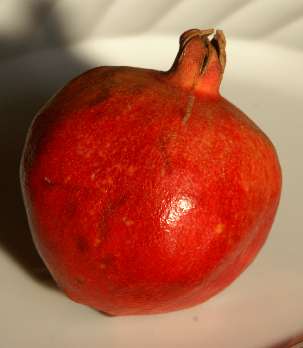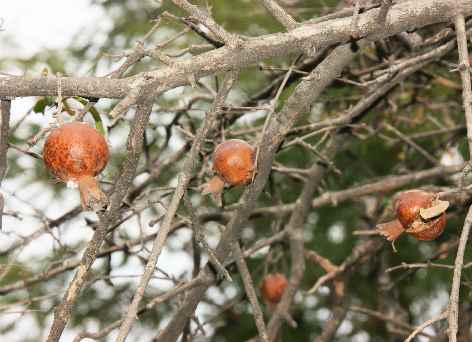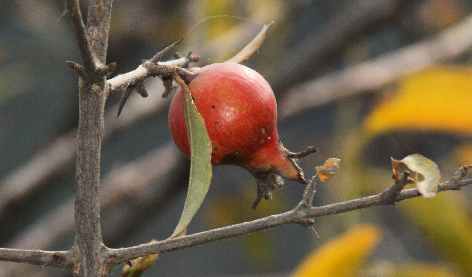| ||
|
If one wants to set up a collection of biblical spices
, one must not forget
that there are three millennia between the language of the Old Testament and
ours; therefore, exact translations are sometimes impossible. The following
quote (Isaiah 28,27) may illustrate the difficulties of translation:
כִּי לֹא בֶחָרוּץ יוּדַשׁ קֶצַח וְאֹופַן עֲגָלָה עַל־כַּמֹּן יוּסָּב כִּי בַמַּטֶּה יֵחָבֶט קֶצַח וְכַמֹּן בַּשָּׁבֶט׃
Ki lo vecharuts yudash qetsach vʿofan ʾagala ʾal-kammon yussav ki vammatte yechabet qetsach vekammon basshabet.
Qetsach is not threshed with a sledge, nor is a cartwheel rolled over kammon; qetsach is beaten out with a rod, and kammon with a stick.
Because of the dialectic structure, we may infer that the two plants are
similar enough to allow for comparison, but differ in the way how the seeds
are harvested. The term kammon [כמן]
is related to Greek kyminon [κύμινον]
and English cumin, and obviously has the same
meaning, as similar forms with the meaning cumin
appear in a multitude
of European languages (mostly originating from Greek via Latin);
but note that also the name caraway
comes
from the same root.
Qetsach [קצח]
is more difficult to analyze. Probably it means nigella, sometimes also called black cumin, whose
seeds ripen in a closed capsule, which must first be opened (this is also the
Modern Hebrew meaning of the word).
Yet in translating the Bible, botanic accuracy is less an aim than general
matters of style. Black cumin
is less elegant than cumin
, and nigella
is
not an English word at all. Therefore, English Bible translations render qetsach as dill, caraway or fitches
, which is an old orthographic
variety for vetch, a plant not edible at all (Vicia
sativa).
German translators, on the other hand, who don’t have
a traditional, elegant word for cumin, commonly
translate kammon as caraway (which
is almost certainly wrong), and have to resort to dill for qetsach, which is even wronger.

|
The goddess of Berlin(6.th century BC, Attica) holding a pomegranate fruit in her hand |
Comparing different translations of the Old Testament, one finds some or
all of the following spices (Hebrew terms are given in fully vocalized writing):
garlic (shum [שׁוּם], usually rendered in archaic spelling garlick
),
onion (betsel [בֶּצֶל]),
nigella (qetsach [קֶצַח],
also rendered as caraway or dill, quite obscure),
cumin (kammon [כַּמֹּן], usually rendered in archaic spelling cummin
but also translated as caraway),
coriander (gad [גַּד]),
caper (abiyonah [אבִיוֹנָה], also translated desire
),
cinnamon (qinnamon [קִנָּמוֹן]),
cassia (qiddah [קִדָּה] and
qətsiʾah [קְצִיעָה], also interpreted as a synonym of cinnamon or cassia buds),
hyssop (ezov [אֵזוֹב], frequent but very obscure),
myrtle (hadas [הֲדַס]),
olive (shemen [שֶׁמֶן] olive oil
and zayith [זַיִת] olive berry; olive tree
; very frequent),
juniper (bərosh [בְּרוֹשׁ], also given as fir
, cypress
or pine
),
almond (shaqed [שָׁקֵד]),
lemon (possibly citron but usually translated apple
, tappuach [תַּפּוּחַ]),
pomegranate (rimmon [רִמּוֹן]),
bay (probably meaning just young tree
, also rendered cedar
, ezrach [אֶזְרָח]),
rose (chavatstseleth [חֲבַצֶּלֶת], very obscure)
and saffron (karkom [כַּרְכֹם]).
Of these plants, only a few also appear also in the Quran; see
ginger for a list of Koranic spices
.
Similarly, the New Testament has not been translated by biologists —
the latter would not have assumed that birds live in
mustard plants (sinapi [σίναπι]).
Other plant names from the New Testament include the following
(original Greek given in parenthesis):
mint (hedyosmon [ἡδύοσμον], this is not the common name of mint in Old Greek),
cumin (kyminon [κύμινον], also translated caraway),
anise (anethon [ἄνηθον], better rendered dill),
lemon (thyinos [θύινος], possibly citron but uncertain),
rue (peganon [πήγανον], probably a close relative is meant),
cinnamon (kinnamomon [κιννάμωμον]),
hyssop (hyssopos [ὕσσωπος], referring to the obscure word in the Old Testament)
and olive (agrielaios [ἀγριέλαιος] olive tree
, elaia [ἐλαία] olive fruit
and elaion [ἔλαιον] olive oil
).
See also mugwort for linguistic notes on another
plant mentioned in the New Testament, wormwood (apsinthos [ἄψινθος]).

|
| Pomegranate flower |

|
| Ripening pomegranates |
Today, pomegranate seeds have culinary importance as a spice only in Northern
India, where they are dried and used as a flavouring. For this purpose, seeds
of wild pomegranates are collected that are too sour to be eaten fresh. This
spice features a subtle, sweet–
Gujarat’s cookery differs from all other regional cuisines of India by its
marked preference for spicy and sweet combinations. Due to a sizable Jain
minority and the influence of Mahatma Gandhi, who was born in the small city of
Porbandar in central Gujarat, its inhabitants are generally strict vegetarians,
stricter than in other North Indian states. Fiery vegetable curries with more
than a simple hint of sweetness are often decorated with fresh pomegranate
seeds as a contrasting garnish.
Grenadine is a reduced juice from fresh pomegranate seeds. It is common in
Northern India not only for desserts, but also to marinate meat; due to its
content of proteolytic enzymes, it acts as a meat tenderizer.
Either as fresh-extracted juice or in the more durable form of syrup (dibs ar-
Lastly, dried pomegranate seeds make an interesting alternative for raisins in
cakes and other European sweets.
















